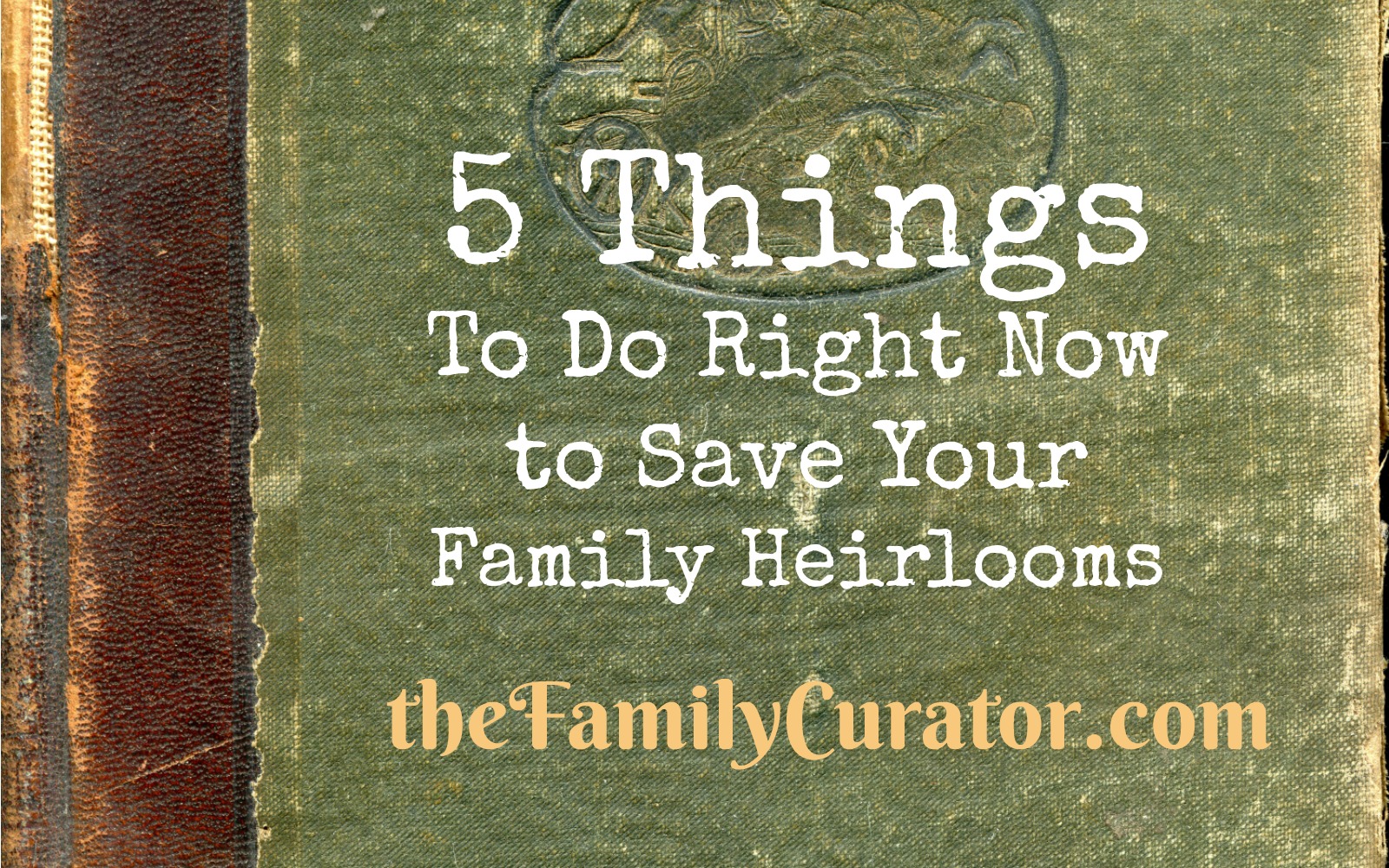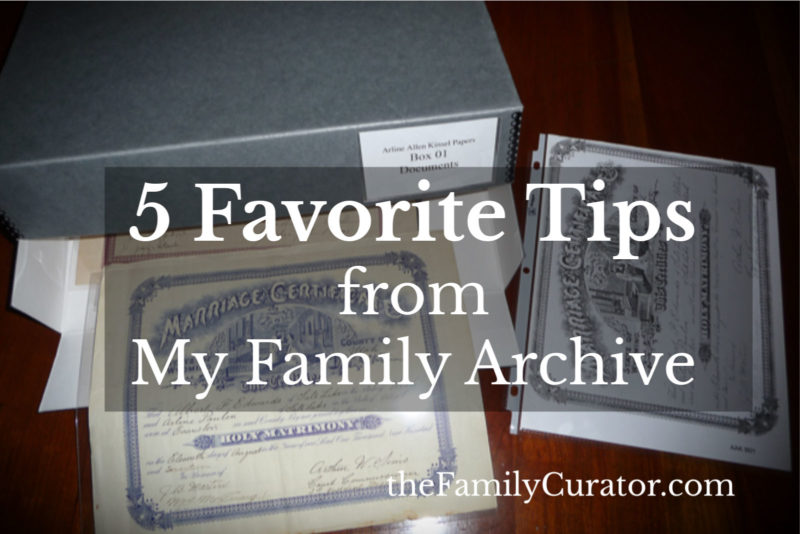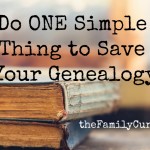 Did you inherit the family treasures? Grandma’s china teacups, your dad’s military medals, and boxes of old photos and albums? You’re not alone. Curator, collector, or caretaker, these five quick tips from How to Archive Family Keepsakes will help preserve your family heirlooms and show you how to be your own family archivist.
Did you inherit the family treasures? Grandma’s china teacups, your dad’s military medals, and boxes of old photos and albums? You’re not alone. Curator, collector, or caretaker, these five quick tips from How to Archive Family Keepsakes will help preserve your family heirlooms and show you how to be your own family archivist.
1. Move Your Heirlooms Out of the Garage
If you’re like a lot of people, you had to quickly empty a family home and the things you wanted to save were stashed into boxes, bags, and bins for storage. They might be stored in the garage, attic, or a storage facility. You didn’t have much choice; you’d did the best you could at the time. That’s okay. Our ancestors stored their trinkets in steamer trunks and bureau drawers. My grandmother liked to keep old newspapers in a suitcase under the bed. When I inherited her collection, I had a lot of work to do!
Home Sweet Family Heirloom Home
If you do nothing else with your family treasures, move them from unheated, unconditioned space in the garage, attic, or shed to a place where the temperature and humidity are moderate and relatively consistent. Museums and archives aim for a relative humidity of 50% and a temperature of about 68 degrees. For a practical home solution, keep your treasures where inside your home in conditions that you find comfortable, typically about 70 degrees with moderate humidity. Good choices for a family archive are:
- an interior closet or shelf away from plumbing or electrical wiring
- cabinet or bureau drawer
- filing cabinet
- temperature controlled storage room
Avoid damp basements, attics, garages, sheds, open baskets, car trunks, porches and other drafty, dirty places. Keep your treasures away from sunlight or artificial light, heaters, air-conditioners, windows, fireplaces, and other sources of light, heat, or water. Store archival boxes at least 12-inches off the floor in case of flooding.
2. Trade Cardboard for Archival Boxes
Now that you’ve identified a likely spot for your family archive you might be thinking, “Yech. I don’t want to bring those dirty old boxes into my house. They might have bugs or mold.” And you’d be right. I like to use Archival Banker’s Boxes as temporary preservation-quality storage for the items I have’t yet organized or sorted. These large acid-free boxes will hold a lot of papers or photos, and keep any crumbling artifacts from leaving a trail throughout your house. Don’t worry right now about going through all the boxes. Just transfer whatever is in the cardboard fruit crate to the acid-free archival banker’s box. Leave individual items grouped as you found them, in shoe boxes, envelopes, or paper bags. DO throw out any dead critters, food, or other toxic items. (Stranger things than dead mice have been found in family collections.)
3. Wash Your Hands
Family papers, photos, and and treasures are dirty. Family heirlooms seem to accumulate their own kind of aged dust and grime. Wash your hands before and after handling your treasures. Wear white cotton or nitrile gloves when handling photos where fingerprints will leave permanent smudges.
4. Keep The Family Together
If you are caring for multiple collections, be careful to keep each collection separate. Write the owner’s name on the outside of the box, and on a sheet of paper, write down the date the collection came into your possession, and who gave it to you. Include the paper inside the box. It may be months before you open the box again, and you’ll be glad you have a few notes as you get started sorting and organizing. Use these tips to Write the History of Your Heirloom and keep it with the item.
5. Keep Your Treasures In the Dark
It might be tempting to keep family photos, albums, or scrapbooks out on a table to enjoy and share, but repeated handling, dust, pets, and light will speed the deterioration of your keepsakes. A better choice is to store the items inside acid-free boxes and bring them out to examine very occasionally. Use good archival practices to display your favorite documents or photos; learn easy display options in the article How to Safely Display Family Photos and Documents. If you don’t have archival storage, place the albums inside a clean white cotton pillowcase and store on a shelf in a dark, clean, closet inside your home with our other family artifacts. Eventually, digital copies and reproduction books like the projects in How to Archive Family Photos can give access without damaging photos or albums. Disclosure: Thank you for supporting The Family Curator by using the affiliate links on this website. 






I have dozens and dozens of older negatives from the early 1900’s through the 1950’s and a few from the early 1960’s.
I have looked at several of them and some are ones from photos we do not have actual copies of. Should I try to have them developed? How do I find someone to develop them? These days, we all have “cell phone” pictures!
Thanks!
Hi Mickie, What a great question. Old film required two steps in processing — first the roll was developed into negatives and then prints were made from the negative. Developing the film was relatively inexpensive, but prints could be costly so sometimes people waited to choose which negatives they truly wanted to see as a photo print. If you have old negatives that you’ve never viewed as prints, you might want to digitize the negative and do the same thing — select which images to print or use for your family history. You’ll need a flatbed scanner with a film carrier to digitize negatives, or most scanning services can do this for you (for a $$$ fee). My older Epson V500 does a beautiful job scanning negatives; similar scanners cost less then $200 and are listed on my Shop Page. Another option is to use a negative scanning setup with a DSLR camera, if you have one available.
Photos printed today from digitized negatives are often better than the original print because digitizing captures the fine detail of the image. Unfortunately, you can’t use your cell phone to scan negatives (yet), but it’s well worth the time and effort to digitize old negatives with a flatbed.
There is a small machine that can be bought that helps to scan & digitize negatives onto a memory card. It’s a Film to Digital Converter. It comes with plastic forms for holding the various negative while scanning and even has a little screen for viewing. Not that expensive.
I haven’t tried these small digitizing devices, crisis, but my experience with a full scanning film is that it is faster to scan several frames at once. A flatbed scanner like the Epson V600 will digitize multiple items this way.
Anytime I see families with heirlooms or important items languishing in their non-temperature controlled garages, I tell them to move their things inside so they don’t get ruined. Might not seem like it right now, but one day you will want to be able to read the papers you’re trying to save. Keep them dry and away from any kind of light.
Right you are! Garages and sheds are the worst, right along with attics and basements. They are so handy for storage, but so damaging for paper and heirlooms.
When my father died, my mother had an instinct to purge. I happened to be there when she was putting a bag of old family certificates (birth, death, marriage, etc) into the garbage. I asked her if I could have them, but now I’m wondering how to preserve the old certificates. They are British and are an odd size (about 14″ long). I actually thought about laminating them. Any ideas?
Please don’t laminate those old certificates! Plastic lamination actually seals paper and can’t be undone. Archives recommend preserving documents in acid-free folders or archival polyester plastic. See my Shop page for recommended products. Look for plastic products that have passed the P.A.T., Photographic Activity Test to know the paper will not be damaged by the plastic enclosure.
The link to “Write the History of Your Heirloom” gave me an error — “This site can’t be reached”. Will you please advise the correct URL?
Thank you,
Sorry, Dorothy. I’ve corrected the link. Please try again. Thank you for letting me know!
Thank you for these good ideas.
You’re very welcome, Judith. I hope you find them helpful.
I enjoyed your article but having macular degeneration I find it much easier to read dark black print on white background. Thank you for the tips on storing personal archives.
Good point, Betty. In the meantime, you might find it helpful to use the “Reader View” that’s available in some browsers. It’s available by clicking on the three lines in the left of the URL window in Safari. Chrome and Firefox also have features to enable Reader view. I use it frequently to cut the clutter when I just want to read an article.